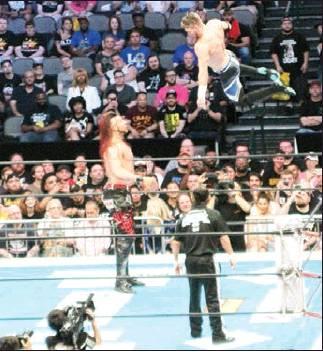Respect.
Sometimes, in the right place and time, it can go both ways, to fantastic results.
Such was the case on a recent Saturday night at American Airlines Center in Dallas, as the building was taken over by rabid fans for New Japan Pro Wrestling’s G1 Climax 29 Night One event.
As the name of the promotion indicates, New Japan is Japan’s hottest wrestling commodity, touring across the nation and culminating in a grand-scale “Wrestle Kingdom” event each January 4 at the Tokyo Dome.
On this night, the company took their talents overseas, competing in the same building that the more familiar WWE brought its “Monday Night Raw” television show to five days earlier. Despite the smaller crowd size, the venue was filled to the brim with noise, with massive reactions to all of NJPW’s top stars.
The respect and gratitude the fans showed was obvious from the start. Those in attendance knew how rare an opportunity to see an authentic show like this was, and were grateful for the company just for setting up its traditional blue-canvassed ring. Before the show, history video packages were shown, showing off the biggest names in NJPW history. These were some of the loudest reactions of the night.
Not only did the fans respect history, they respected the NJPW style of wrestling. In modern American pro wrestling, the focus has shifted from the lumbering days of André the Giant to a more fast-paced, high-flying style, based on the lucha libre style of Mexican competitors. While American wrestling has shifted, Japan has stayed largely the same, focusing on “strong style,” a combination of hard strikes and impressive mat wrestling.
During a G1 tournament match between wrestlers Zack Sabre Jr. and SANADA, this style was on full display, and the crowd ate it up, chanting “New Japan.” In another contest featuring Tomohiro Ishii, a simple wrestling move, a suplex, put the AAC crowd on its feet with applause.
So why the crazy reactions for the most basic of wrestling encounters? After all, WWE matches feature big moves for 15-20 minutes straight, many times to minimal recognition.
The answer lies in how the stories are told in the ring. Matches in a NJPW setting are designed to look more like a traditional fight, with focus on counter maneuvers. While moves such as suplexes are eventually applied, they are more rare than they would be in a WWE match. The audience suspended their disbelief, a key component to any wrestling crowd, and appreciated the “struggle” to achieve even the most basic of moves.
Audiences for New Japan are also eagle-eyed, as was the case in the matchup between KENTA, formerly Hideo Itami of WWE, and Kota Ibushi. Early in the match, Ibushi suffered what appeared to be an injury to his ankle, which the crowd picked up on. The G1 tournament, the main focus of the show, is a month-long round-robin slog featuring 20 of NJPW’s top competitors, including Ibushi. Having an injury on night one of the tournament, obviously, is not ideal. Nonetheless, the audience showed their appreciation for Ibushi toughing out the encounter, ending in a loss to KENTA.
When the match concluded, the respect the fans had shown all night was reciprocated. KENTA, whose character is based on respect, turned to the crowd and soaked in the applause. Then, he started clapping right back.
For a Japanese legend that slowly faded into obscurity during a five-year WWE tenure, KENTA was appreciative that the audience still recognized his elite skill set. The crowd knew what this event meant to him, and he knew how special it was for the fans. The respect went both ways.
One of the best moments of the night happened when the lights were down, and the entrance ramp was empty, until one pair of red shoes trotted down. Referee Hiroyuki Umino, known affectionately as “Red Shoes” thanks to his attire, came out to officiate the next match on the card. For the fans, seeing Red Shoes was like seeing a movie star in his or her prime, a real relic of NJPW lore that symbolized to the crowd that this was the authentic NJPW experience.
They treated Red Shoes as such, breaking out into wild applause. The adoration didn’t stop there, as during the next match, they chanted “Let’s go Red Shoes!” instead of cheering on the two competitors in the ring.
This token of gratitude paid by the AAC crowd meant they respected the culture, history, and even minute details of New Japan, such as their favorite referee.
On this night, the mutual respect blossomed into a spectacular showcase for New Japan’s finest.

